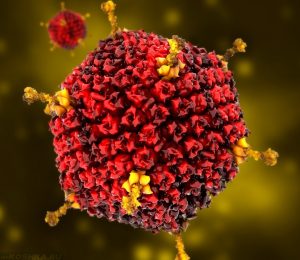
“Throat and stomach ache”, or what you know about adenovirus
During the period of seasonal acute respiratory viral infections, cough and sore throat is an “expected” phenomenon. But what if traditional respiratory symptoms are combined with diarrhea or vomiting? Perhaps it is an adenovirus infection.
Special features
Adenovirus, unlike many respiratory viruses, affects not only the respiratory tract, but also the mucous membrane of the small intestine. In addition, the conjunctiva of the eye is “under attack”.
This leads to:
profuse mucous discharge from the nose,
sore throat and sore throat,
cough (first dry, and later with sputum),
symptoms of conjunctivitis, in the form of redness of the eyes, lacrimation, feeling of dryness and “sand” in the eyes,
as well as abdominal pain, diarrhea, vomiting
and fever, which can last up to 2 weeks.
At the same time, if intestinal symptoms may not develop for the entire infection, then “characteristic” eyes are an important distinguishing feature of adenovirus.
Where can you get infected
Adenovirus is extremely infectious and resistant in the external environment. And sick people or household items on which the virus remains active for up to 8 days can become a source of infection.
You can get infected:
when a patient coughs and sneezes,
eating food prepared by him without observing sanitary standards (thorough hand washing is necessary),
and even through contact with the feces of an infected person (for example, when changing a diaper to an infected child).
You can “catch” the virus even in the pool, with insufficient water disinfection. And, obviously, this viral infection is not uncommon in children’s groups.
How dangerous is it
Adenovirus infection, in most cases, does not pose a threat to health and life. And it usually ends without consequences after 7-14 days. Whereas in debilitated patients, the infection can be prolonged and reach 6 weeks.
The same category of patients most often develop complications, in the form of:
pneumonia,
otitis media,
bronchospasm
severe keratoconjunctivitis.
However, Rospotrebnazor experts note that complications of adenovirus infection are always associated with the addition of pathogenic bacterial flora (staphylococci, streptococci and others).
How to identify adenovirus
The classic symptoms of adenovirus infection, as a rule, do not require additional tests. And the help of laboratory diagnostic methods is mainly resorted to at the earliest stage of the infectious process or in case of doubt about the diagnosis.
The most informative analysis in this case is PCR diagnostics of the material (smear from the throat or feces) for adenovirus.
The study can be ordered separately or immediately in combination with other ARVI viruses (for example, “ARVI-Screen”), which will allow you to immediately carry out differential diagnostics. True, the PCR technique dramatically loses its reliability if treatment has already been started, both local (rinsing, sprays) and of a general nature.
A blood test for IgA https://en.wikipedia.org/wiki/Immunoglobulin_A antibodies to adenovirus is devoid of these shortcomings.
They appear in the blood at the initial stage of the disease, and continue to circulate for some time after recovery.
However, children, as you know, do not like blood tests, so this examination format is more suitable for adults.
During the period of seasonal acute respiratory viral infections, cough and sore throat is an “expected” phenomenon. But what if traditional respiratory symptoms are combined with diarrhea or vomiting? Perhaps it is an adenovirus infection. Special features Adenovirus, unlike many respiratory viruses, affects not only the respiratory tract, but also the mucous membrane of the…